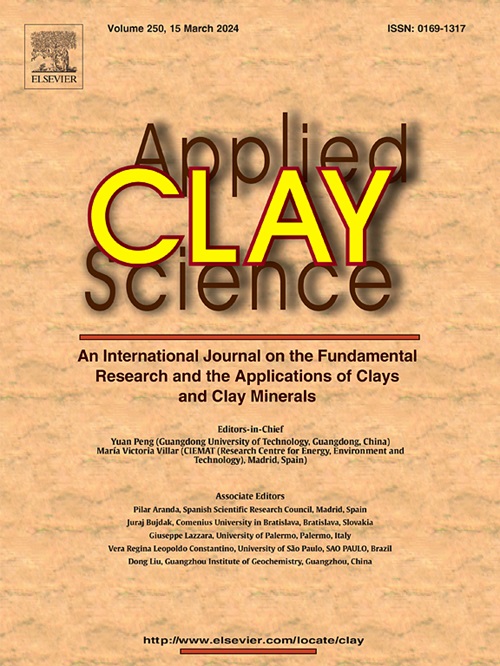黏土和微藻对布贾诺瓦茨样球分子分布变化影响的地球化学视角:自然系统与实验室设计系统的比较研究
IF 5.8
2区 地球科学
Q2 CHEMISTRY, PHYSICAL
引用次数: 0
摘要
在类球粒成熟过程中,粘土矿物显著影响有机质(OM)的(生物)地球化学转化,促进有益脂类化合物的产生,从而提高其生物学价值。本研究研究了在一个非标准的两年老化期间,粘土矿物对改变布雅诺瓦茨样岩OM组成的影响。在这种情况下,用气相色谱-质谱法跟踪了正烷烃、正醛和脂肪酸甲酯(FAME)分布的变化,同时用x射线粉末衍射分析了矿物相。通过检查地质(似球粒前)样品以及原始和应用的似球粒来监测成熟度变化。黏土矿物在有机质成熟过程中起催化作用,长链奇数烷烃(n-C27、n-C29、n-C31)相对丰度下降,中链偶数烷烃(n-C24)相对丰度增加。地质样品的特征是存在C16-C32的正醛,不存在正醛,而原始和应用的布雅诺瓦克样体富含C18-C32的连链正醛和正醛。偶数正醛可能是通过FAMEs的去酯化反应和后来的游离脂肪酸的β-氧化反应形成的。该研究还通过跟踪微藻化合物对其OM的富集,探索了创建实验室设计的微藻类球体的潜力。在实验室设计的球体中,微藻正构烷烃主导了可溶性OM (SOM)。这一结果是可以预料到的,因为布雅诺瓦茨样体的SOM含量大约比微藻低135倍。无论最初的OM特征或粘土矿物相如何,将用微藻化合物人工富集有机贫质体,从而调整其在保健实践中的潜在应用。本文章由计算机程序翻译,如有差异,请以英文原文为准。
Geochemical perspective on the impact of clays and microalgae on changes in the molecular distribution of the Bujanovac peloid: A comparative study of natural versus laboratory-designed systems
During the maturation of peloids, clay minerals significantly influence the (bio)geochemical transformations of organic matter (OM), promoting the production of beneficial lipid compounds that enhance their balneological value. This study investigated the impact of clay minerals on altering the OM composition of the Bujanovac peloid during a non-standard two-year aging period. In this context, variations in n-alkane, n-aldehyde, and fatty acid methyl ester (FAME) distributions were tracked using gas chromatography–mass spectrometry, while the mineral phase was analyzed by X-ray powder diffraction. Maturation changes were monitored by examining the geological (pre-peloid) sample, as well as raw and applied peloids.
Clay minerals played a catalytic role in the maturation process of the OM, in which the relative abundance of odd long-chain n-C27, n-C29, and n-C31 alkanes declined, followed by an increase in even mid-chain n-C24 alkane in the peloids' OM. The geological sample characterized the presence of C16–C32 FAMEs and the absence of n-aldehydes, whereas the raw and applied Bujanovac peloids were rich in even-chain n-aldehydes (C18–C32) and FAMEs. Even-numbered n-aldehydes were likely formed via the de-esterification of FAMEs and, later, the β-oxidation of free fatty acids.
The study also explored the potential for creating a laboratory-designed microalgal peloid by tracking the enrichment of its OM with microalgal compounds. Microalgal n-alkanes dominated the soluble OM (SOM) in the laboratory-designed peloid. This outcome is anticipated since the SOM content of the Bujanovac peloid is roughly 135 times lower than that of microalgae. Regardless of the initial OM characteristics or the clay mineral phase, organic-poor peloids will be artificially enriched with microalgal compounds, thereby adjusting their potential application in wellness practices.
求助全文
通过发布文献求助,成功后即可免费获取论文全文。
去求助
来源期刊

Applied Clay Science
地学-矿物学
CiteScore
10.30
自引率
10.70%
发文量
289
审稿时长
39 days
期刊介绍:
Applied Clay Science aims to be an international journal attracting high quality scientific papers on clays and clay minerals, including research papers, reviews, and technical notes. The journal covers typical subjects of Fundamental and Applied Clay Science such as:
• Synthesis and purification
• Structural, crystallographic and mineralogical properties of clays and clay minerals
• Thermal properties of clays and clay minerals
• Physico-chemical properties including i) surface and interface properties; ii) thermodynamic properties; iii) mechanical properties
• Interaction with water, with polar and apolar molecules
• Colloidal properties and rheology
• Adsorption, Intercalation, Ionic exchange
• Genesis and deposits of clay minerals
• Geology and geochemistry of clays
• Modification of clays and clay minerals properties by thermal and physical treatments
• Modification by chemical treatments with organic and inorganic molecules(organoclays, pillared clays)
• Modification by biological microorganisms. etc...
 求助内容:
求助内容: 应助结果提醒方式:
应助结果提醒方式:


